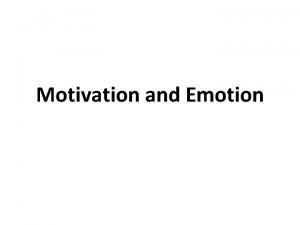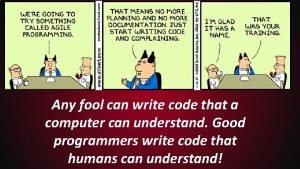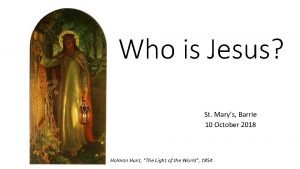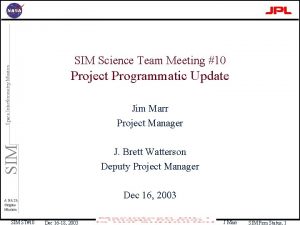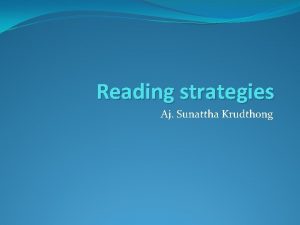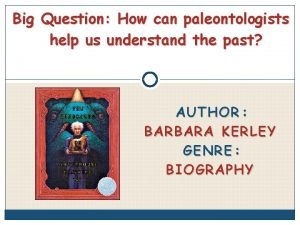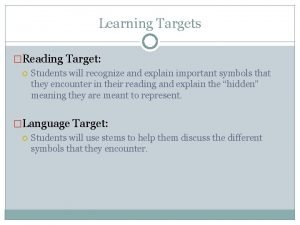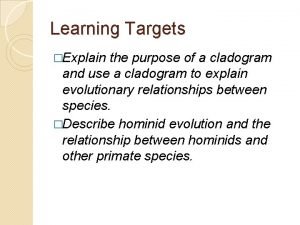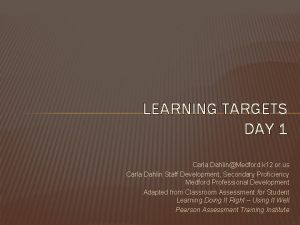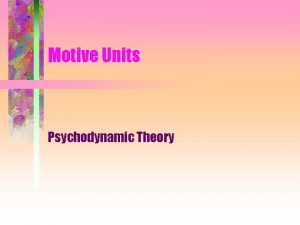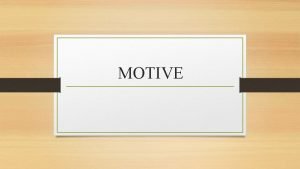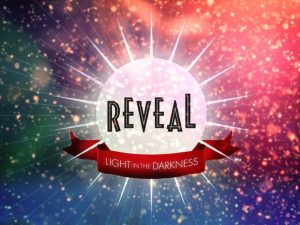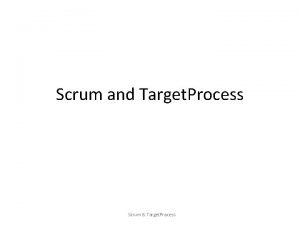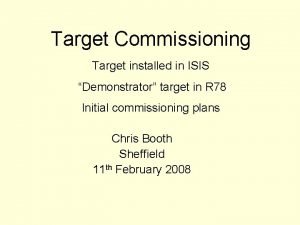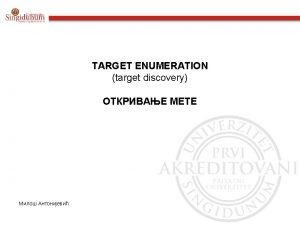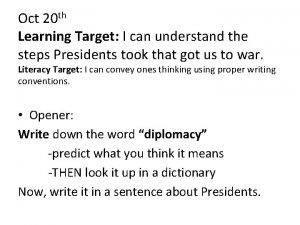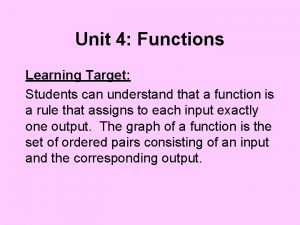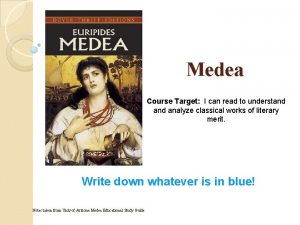LEARNING TARGET HOW CAN WE UNDERSTAND MARYS MOTIVE




















- Slides: 20

LEARNING TARGET: : HOW CAN WE UNDERSTAND MARY’S MOTIVE BEHIND “LAMB TO THE SLAUGHTER”? Warm Up: S, Q, E: Identify and explain the central idea of the story. Provide a quote to support your idea. Homework: Print “Dahl Dark Humor…”

DESCRIBE MARY & PATRICK’S CHARACTERISTICS v Think about the 7 ways to characterize a character. 1. 2. 3. 4. 5. 6. 7. Direct explanation by author Detail which shows individuality Surroundings Thoughts Reaction of and to other characters Conversation Action

MARY’S CHARACTERISTICS v. Mary is described as a seemingly content housewife with a calm-demeanor and is almost saint-like. v. She is the one taking care of her husband v. Ex. Making him drinks, cooking dinner etc. v. Find other examples that characterize Mary

PATRICK’S CHARACTERISTICS. v. He is described as being in control, emotionally detached and self-centered. v. Describe his behavior when he enters the house. v He plays with his glass filled with ice, “holding the tall glass with both hands, rocking it so the ice cubes tinkled against the side. ” What could this mean?

HOW IS THE GLASS OF WHISKEY AND ICE DESCRIBED? v Underline and identify the description in the text v Why does Dahl focus on the sound of the ice cubes?

HOW IS THE GLASS OF WHISKEY AND ICE DESCRIBED? v The ice in the glass is described at various times as tinkling “against the side” and “falling against the bottom of the empty glass. ” v In addition, “She hears the ice cubes clinking against the side of the glass. ” v Dahl focuses on the sound of the ice cubes to give readers an understanding of the atmosphere, tension, and the almost deadly silence in the room.

DESCRIBE THE CHANGES IN PATRICK’S DEMEANOR AND COMMENTS v. Find at least 2 quotes that shows a shift in the tone he takes with Mary

DESCRIBE THE CHANGES IN PATRICK’S DEMEANOR AND COMMENTS v Patrick treats her very brusquely telling her to sit down. v After he has a second drink and refuses dinner for a second time, he tells her to “sit down…just for a minute, sit down. ” v This is the first direct order he has given her, a break from the placid personality she has come to expect. v He then tells matter-of-factly that he is leaving her. v Her actions show her changing from adoring to horrified to robotic

HOW DOES MARY’S BEHAVIOR AT THE GROCERY STORE CONTRADICT WHAT HAS HAPPENED EARLIER IN THE STORY? v Think about her initial reaction to the events. v How do her feelings change?

HOW DOES MARY’S BEHAVIOR AT THE GROCERY STORE CONTRADICT WHAT HAS HAPPENED EARLIER IN THE STORY? v. Before going out, she rehearses her smile and greeting, so that she will be able to smile “brightly” at the man behind the counter vshe wants the clerk to think she is making since her husband has said he was “tired and doesn’t want to eat out tonight. ”

HOW DOES MARY’S BEHAVIOR AT THE GROCERY STORE CONTRADICT WHAT HAS HAPPENED EARLIER IN THE STORY? v. She is able to provide a believable alibi for her time. v Although before she was “horrified” regarding the events of the night, now she is in control planning her alibi.

HOW DOES THE STRUCTURE OF THE SENTENCE REFLECT HER THINKING AT THAT MOMENT? v “And now, she told herself as she hurried back…” This paragraph starts off with a long sentence. (Pg 3) v This is where either she becomes a very calculating murderer. v She is planning the steps to her alibi and the way she will be able to get away with the murder, or the point where she breaks totally with reality.

HOW DOES THE STRUCTURE OF THE SENTENCE REFLECT HER THINKING AT THAT MOMENT? v She is trying to explain the events as logically as she could. v The length of the sentence also indicates a sense of rambling which may be caused by Mary’s nervousness. v Her mind seems to be racing and she is frantic while trying to keep her body as calm as can be.

THE POLICE OFFICERS DO NOT SUSPECT MARY FOR THE MURDER. v. How does her behavior play a role in assuring this didn’t happen? v She played the role of a distraught wife. v she wept hysterically when the officers first came and later continued to sob as she told her story of discovery. v The officers did not suspect she was the murderer, they treated her kindly but they only quickly and checked out her alibi.

THE POLICE OFFICERS DO NOT SUSPECT MARY FOR THE MURDER. v. How does her behavior play a role in assuring this didn’t happen?

THE POLICE OFFICERS DO NOT SUSPECT MARY FOR THE MURDER. v. How does her behavior play a role in assuring this didn’t happen? v After it was verified, they seem to have lost interest in her as a suspect. v She continued to act innocent as she felt she couldn’t move and didn’t feel too good while the investigation was happening. v Finally, she could not “touch a thing” of the meal she had prepared once it was cooked.

HOW DOES MARY GET RID OF THE MURDER WEAPON?

HOW DOES MARY GET RID OF THE MURDER WEAPON? v The police eat the lamb in the end when Mary offers to feed them. v It is literally “under their nose” when that statement is made. v Dahl foreshadows this event from the point when Mary takes the leg of lamb, “placed it in a pan, turned the oven on high and shoved it inside. ”

HOW DOES MARY GET RID OF THE MURDER WEAPON? v The cooking meat is again referred to during her trip to the store as she admits to “cooking it frozen” and “taking a chance on it this time. ” v , Just as the detectives’ voices were “think and sloppy because their mouths were full of meat, ” their investigation was sloppy as well. v Finally, they admit that she wanted them to finish it as they would be doing her a favor. v While they believe that favor was born from hospitality, when, in fact, they did her the favor by destroying the evidence.

“LAMB TO THE SLAUGHTER” v Like lamb to slaughter” is a biblical allusion, usually referring to the sacrifice of an innocent, but here it could have many interpretations: v Mary the innocent lamb being slaughtered by her husband’s words and actions. v The irony of Mary (the lamb), killing her husband. v The weapon, a leg of lamb, being cooked and eaten (slaughtered) by the officers.
 Emotions vs feelings examples
Emotions vs feelings examples To understand recursion you must understand recursion
To understand recursion you must understand recursion Any fool can write code that a computer can understand
Any fool can write code that a computer can understand St. marys county land use and zoning lawyer
St. marys county land use and zoning lawyer St marys barrie
St marys barrie St marys college arklow
St marys college arklow Victoria and albert ward st mary's hospital
Victoria and albert ward st mary's hospital St mary's collinstown
St mary's collinstown Simspace st marys
Simspace st marys Marys river
Marys river St marys
St marys Primary target market and secondary target market
Primary target market and secondary target market We can understand from the reading that opera
We can understand from the reading that opera How can paleontologists help us understand the past
How can paleontologists help us understand the past Can we understand god
Can we understand god Cuadro comparativo e-learning m-learning b-learning
Cuadro comparativo e-learning m-learning b-learning Learning target examples math
Learning target examples math What does janie overalls symbolize
What does janie overalls symbolize Primate cladogram
Primate cladogram Product learning target example
Product learning target example Types of needs analysis in esp
Types of needs analysis in esp
